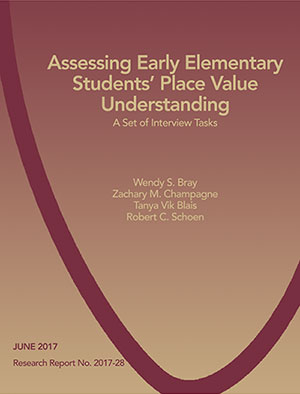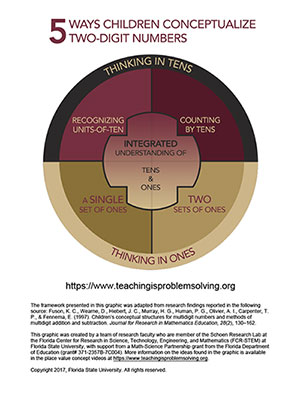This page contains resources to support teaching and learning of place-value concepts. Three videos draw on research-based frameworks to illuminate the rich and complex topic of place value and how children come to understand this topic. Additionally an interview protocol for diagnosing student understanding of place value is available along with video examples of students participating in that interview. Finally a list of additional resources is offered for those who wish to go further with study of this topic.
Educator Videos
The following three videos contain a discussion and synthesis of research-based frameworks that can be useful for making sense of student understanding of place-value concepts and an interview protocol in PDF format used to assess students understanding of place value during these interviews.
The Multifaceted Nature of Place Value: It’s About More Than Digit Values
11:56 / View on YouTube / Download Transcript
The Child’s Perspective on Place Value: Five Ways Children Conceptualize Two-Digit Numbers
12:08 / View on YouTube / Download Transcript
Provoking Place-Value Reasoning with Groups of Ten Word Problems: Excerpts from Ms. Brannon’s First Grade Class
14:41 / View on YouTube / Download Transcript
Place-Value Assessment Resources
Click the thumbnails to access resources to support assessment of students’ understanding of place-value in a base-ten number system. The assessment designed to be used in a one-on-one interview setting. Blackline masters are also available in the downloadable file. The downloadable diagram provides a conceptual model for the various components of place-value understanding that occur over a period of several years of school mathematics.
Student Videos
The following three videos show a kindergarten student, a first-grade student, and a second-grade student engaged in the place-value interview.
Kindergarten – Tim
19:51 / View on YouTube / Download Transcript
First Grade – Weston
30:00 / View on YouTube / Download Transcript
Second Grade – Valerie
23:47 / View on YouTube / Download Transcript
Resources for Further Study of Place Value
Click the following titles to access a short list of teacher resource books and journal articles that were reviewed in preparation of these resources.
Teacher Resource Books
- Carpenter T. P. Fennema E. Franke M. L. Levi L. & Empson S. B. (2015). Children’s Mathematics: Cognitively Guided Instruction (2nded.) Portsmouth NH: Heinemann.
- This book details research findings on the development of children’s mathematical thinking in relation to the four operations (addition subtraction multiplication and division) and base-ten number concepts.
- Richardson K. (1999). Developing Number Concepts: Place-Value Multiplication and Division. Parsippany NJ: Dale Seymour Publications.
- Chapter one of this book includes ideas for teaching and assessing place-value concepts. The book also contains a collection of activities focused on providing children with a variety of experiences generating strategies for organizing large quantities into tens and ones.
- Wickett M. & Burns M. (2002). Lessons for introducing place value. Sausalito CA: Math Solutions.
- This book includes a collection of ideas for teaching and assessing place-value concepts. Lessons are organized into three main types: Counting and grouping activities number chart activities and activities focused on exchanging ones and tens. The assessments chapter contains suggestions for tasks to use in an individual interview.
- Van de Walle J. A. Lovin L. H. Karp K. S. & Bay-Williams J. M. (2018). Teaching student-centered mathematics: Developmentally appropriate instruction for grades preK-2 (3rd edition). New York: Pearson.
- Chapter eleven of this book includes discussion of children’s development of whole-number place-value concepts and ideas for instruction and assessment related to these concepts.
- Bray W. S. & Blais T. V. (2017). Stimulating base-ten reasoning with context. Teaching Children Mathematics 24(2) 121-127.
- This article illustrates how contextualized problems involving groups of ten can be used to advance early elementary students’ understanding of place-value concepts.
- Chan W. L. C. Au T. K. & Tang J. (2014). Strategic counting: A novel assessment of place-value understanding. Learning and Instruction 29 78-94
- This article introduces a set of strategic counting tasks’ to use for the purpose of assessing children’s place-value understanding. The authors discuss the advantages of the strategic counting tasks over other tasks commonly used to assess place-value understanding and detail findings of three research studies that used this set of tasks.
- Fuson K. C. Wearne D. Hiebert J. C. Murray H. G. Human P. G. Olivier A. I. Carpenter T. P. & Fennema E. (1997). Children’s conceptual structures for multidigit numbers and methods of multidigit addition and subtraction. Journal for Research in Mathematics Education 28(2) 130-162.
- Drawing on data from four research projects implementing a problem-solving approach to teaching and learning multidigit number concepts and operations this article presents a framework of conceptual structures that articulate different ways children think about multidigit numbers. The article also discusses categories of methods children devise to solve multidigit addition and subtraction problems. The research in this article forms the basis of the ideas presented in The Child’s Perspective on Place Value: Five Ways Children Conceptualize Two-Digit Numbers (see above).
- Jones G. A. & Thorton C. A. (1993). Children’s understanding of place value: A framework for curriculum development and assessment. Young Children 48(5) 12-18.
- This article draws on the work of multiple research projects to identify curricular elements essential for the development of place-value understanding. A framework is suggested for nurturing and assessing place-value understanding in the early elementary grades.
- Ross S. H. (1989). Parts wholes and place value: A developmental view. Arithmetic Teacher 36(6) 47-51.
- This article describes findings of two studies utilizing digit-correspondence tasks to explore students’ understanding of the meaning of the digits in two-digit numbers. Implications for the classroom are also discussed.
- Ross S. R. (2002). Place value: Problem solving and written assessment. Teaching Children Mathematics 8(7) 419-423.
- This article describes findings from a classroom study that explores the effects of classroom lessons involving digit-correspondence tasks on students’ understanding of the meaning of the digits in two- and three-digit numbers.


